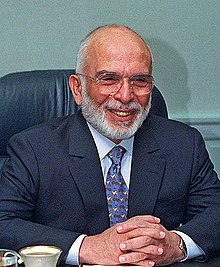
Back Hoessein van Jordanië Afrikaans الحسين بن طلال Arabic الحسين بن طلال ARZ ملک حسین AZB Хусейн бен Талал Byelorussian Хусейн I (Йордания) Bulgarian হুসাইন, জর্ডানের রাজা Bengali/Bangla Hussein Iañ Jordania Breton Husein, kralj Jordana BS Hussein I de Jordània Catalan
A request that this article title be changed to Hussein, King of Jordan is under discussion. Please do not move this article until the discussion is closed. |
Hussein bin Talal (Arabic: الحسين بن طلال, romanized: Al-Ḥusayn bin Ṭalāl; 14 November 1935 – 7 February 1999) was King of Jordan from 11 August 1952 until his death in 1999. As a member of the Hashemite dynasty, the royal family of Jordan since 1921, Hussein was a 40th-generation direct descendant of the Islamic prophet Muhammad.
Hussein was born in Amman as the eldest child of Talal bin Abdullah and Zein Al-Sharaf. Talal was then the heir to his own father, King Abdullah I. Hussein began his schooling in Amman, continuing his education abroad. After Talal became king in 1951, Hussein was named heir apparent. The Jordanian Parliament forced Talal to abdicate a year later due to his illness, and a regency council was appointed until Hussein came of age. He was enthroned at the age of 17 on 2 May 1953. Hussein was married four separate times and fathered eleven children.
Hussein, a constitutional monarch, started his rule by allowing the formation of the only democratically elected government in Jordan's history in 1956, which he forced to resign a few months later, declaring martial law and banning political parties. Under Hussein, Jordan fought three wars against Israel, including the 1967 Six-Day War, which ended in Jordan's loss of the West Bank. In 1970, Hussein expelled Palestinian fighters from Jordan in what became known as Black September. The King renounced Jordan's ties to the West Bank in 1988 after the Palestine Liberation Organization was recognized internationally as the sole representative of the Palestinians. He lifted martial law and reintroduced elections in 1989 when riots over price hikes spread in southern Jordan. In 1994 he became the second Arab head of state to sign a peace treaty with Israel.
At the time of Hussein's accession in 1953, Jordan was a young nation and controlled the West Bank. The country had few natural resources, and a large Palestinian refugee population as a result of the 1948 Arab–Israeli War. Hussein led his country through four turbulent decades of the Arab–Israeli conflict and the Cold War, successfully balancing pressures from Arab nationalists, Islamists, the Soviet Union, Western countries, and Israel, transforming Jordan by the end of his 46-year reign into a stable modern state. After 1967 he engaged in efforts to solve the Israeli–Palestinian conflict. He acted as a conciliatory intermediate between various Middle Eastern rivals, and came to be seen as the region's peacemaker. He was revered for pardoning political dissidents and opponents, and giving them senior posts in the government. Hussein, who survived dozens of assassination attempts and plots to overthrow him, was the region's longest-reigning leader. He died at the age of 63 from cancer in 1999 and was succeeded by his eldest son, Abdullah II.

